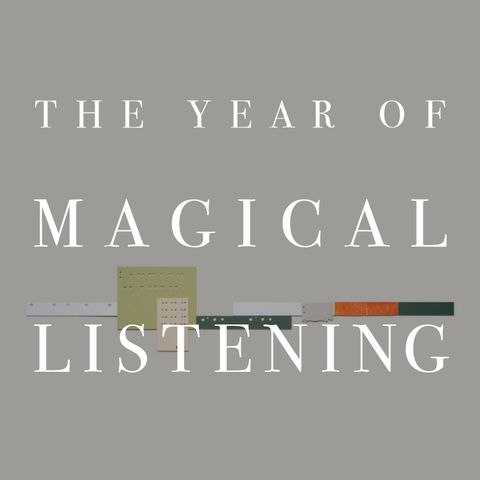033 :: STILL

Sign up for free
Listen to this episode and many more. Enjoy the best podcasts on Spreaker!
Download and listen anywhere
Download your favorite episodes and enjoy them, wherever you are! Sign up or log in now to access offline listening.
Description
FEATURING Sti.ll and Stil. by Taylor Deupree, released by 12k in 2024 and 2002. Listen (https://songwhip.com/taylordeupree/still / https://songwhip.com/taylordeupree/stil1998) / Buy direct (https://taylordeupree.bandcamp.com/album/sti-ll-2 / https://taylordeupree.bandcamp.com/album/stil) - https://songwhip.com/taylordeupree/snowsand-for-clarinets-vibraphone-cello-and-percussion (2024) - https://songwhip.com/taylordeupree/snowsand (2002) ...
show moreSti.ll and Stil. by Taylor Deupree, released by 12k in 2024 and 2002. Listen (Sti.ll / Stil.) / Buy direct (Sti.ll / Stil.)
TRANSCRIPT
There's a story behind this music, and I'll get to it in time. You can't discuss this music without going into it. But to begin, I just want to take this music in on its own terms, simply for what it itself presents: its sounds, its warmth, its hypnotic repetition.
There are only four instruments at play, as the song's title tells us: clarinets, in interwoven harmony; vibraphone, with its single well-timed chime; cello, providing a low ostinato drone; and percussion, in the form of a lone thumping downbeat and a persistent background hiss. Listen closely, and you can pry the different instruments apart; but listen more sensuously, less mediated by thought, and all the instruments blend together into one: a single, breathing organism, pulsating with life.
I'm no stranger to ambient, minimalist music. And so, I find it difficult to explain its appeal to someone who doesn't already see it. It is, at first blush, music that is stripped of so much of what we typically appreciate in music: dynamism and contrast, thematic development, the individual expression of emotion. But in fact, all that is still here, but just in miniature. This is music that makes us hear the slightest shifts in pitch and tempo as momentous; music that develops gradually, almost imperceptibly, across time; music that is still expressive of emotion but an emotion that is a cool, contemplative mood. It is music whose drama unfolds over the smallest intricacies of sound, and so makes us newly alive to all those details – to the way that even the simplest sounds contain within them a symphony of ideas.
We could, at this point, continue to appreciate this music for what it is – how its original loop is now starting to phase, as the clarinets bend and the chimes recur more rapidly. But like I said at the top, there's a story behind this music, and I can't neglect to mention it. Because this music is not, in fact, an original composition, but rather a reimagining of an earlier work by the same artist – an acoustic rendition of resolutely electronic music. So let us momentarily break the spell of this piece and flip to hear its original counterpart.
What a strange and familiar new world, like a parallel universe to what we were hearing before. Sonically, all the same elements are here, but the winds and strings and chimes are now all synthesizers, and the "percussion" is the glitchy crackle of mechanically looped tape. Yet the overall effect of this change in ensemble is a radically altered soundscape that I can only describe as subaquatic, as if the first performance we heard has been submerged underwater, and what we're hearing now is a distant echo ringing out across the ocean's depths. But of course, this piece is not the echo but the original, and what we originally heard is the echo of this, but an echo that brings it into sharper focus and breathes into it new life. So let's snap back.
At this point, you may rightly be asking yourself, Why do this? Why painstakingly work to acoustically recreate music that was, in its original conception, so essentially digital and defined by coincidence? No answer, of course, can fully satisfy this question; there is no sense in which this piece needs to exist. The only answer that can be given is the same answer that must be given to justify the existence of any work of art: Why do anything? Why not?
All music, I suppose, is about disclosing the beauty in arranged sound. In the original version of this piece, that beauty was an emergent phenomenon, the result of the chance encounters of sound produced by a process of mechanical repetition. In this reconstructed version, that beauty is treated as if every movement of the original was an intentional choice. Because beauty, when revealed to us, never seems accidental. Every detail of the original must be replicated, because that's how everything was meant to be. This performance makes us hear that. In listening to these musicians, we are awed in equal parts by their ability to be so precise and by the beauty of this particular arrangement of sound. What may originally have seemed a serendipitous assemblage now appears as a meticulously orchestrated ensemble.
All art is imitation, according to a classic line. Perhaps all art is even, at some level, imitation of other art. But imitation needn't always be thought of as diminution, a pale facsimile of the genuine article. Sometimes, as this piece demonstrates, an imitation of an imitation can become its own original: fuller, clearer, more real, making manifest the beauty that was there all along.
Information
| Author | Willie Costello |
| Organization | Willie Costello |
| Website | theyearofmagicallistening.com |
| Tags |
Copyright 2024 - Spreaker Inc. an iHeartMedia Company
